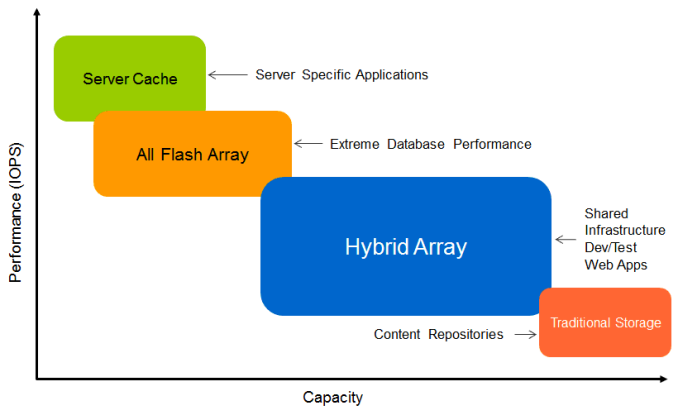The Impact of Disruptive Technologies on the Professional Storage Market
by Johan De Gelas on August 5, 2013 9:00 AM EST- Posted in
- IT Computing
- SSDs
- Enterprise
- Enterprise SSDs
Conclusions
The storage market is finally waking up from its long hibernation. After years of high prices for underperforming SAN storage systems, Fusion-IO is challenging the storage giants with products that are engineered to take MLC flash to its full potential. The result is that even relatively cheap storage systems can deliver higher IOPs than the fastest SANs of the traditional SAN vendors.
NetApp did not fall asleep though: it integrated flash everywhere they could. If your budget is limited, you will not be very enthusiastic as the flash acceleration comes with a huge premium. If you are running expensive software and are already a NetApp customer, however, these new innovations are probably the only way to offer excellent response times. As you can reduce the spindle count, the price per TB and performance per dollar get a lot better.
But the age of the storage OS of the traditional SAN vendors is showing: adding flash everywhere and updating the OS is not as efficient as engineering a product from the ground up to make the most of flash. It is clear that NetApp and EMC have the best solutions for the traditional storage market, but they are facing heavy competition in the much faster growing "Hybrid Array" and "All Flash Array" markets. And many customer are looking beyond the traditional SANs.
Nutanix has lured away lots of customers who wanted something less complex to run VDI. CloudFounders has and will make heads turn as those with large amounts of data cannot ignore the fact that the current RAID algorithms cannot cope with tens of terrabytes very well, let alone Petabytes. The Bitspread technology of Amplidata allowed CloudFounders to build a storage system that comes with an unseen flexibility and availability. The current SAN vendors can only match this with their most expensive clusters and storage gateways, while CloudFounders uses very inexpensive Supermicro servers and SATA disks.
The storage market is changing, and those who ignore the winds of change will have to spend a lot of cash only to end up with fewer IOPs.











60 Comments
View All Comments
Jammrock - Monday, August 5, 2013 - link
Great write up, Johan.The Fusion-IO ioDrive Octal was designed for the NSA. These babies are probably why they could spy on the entire Internet without ever running low on storage IO. Unsurprisingly that bit about the Octal being designed for the US government is no longer on their site :)
Seemone - Monday, August 5, 2013 - link
I find the lack of ZFS disturbing.Guspaz - Monday, August 5, 2013 - link
Yeah, you could probably get pretty far throwing a bunch of drives into a well configured ZFS box (striped raidz2/3? Mirrored stripes? Balance performance versus redundancy and take your pick) and throwing some enterprise SSDs in front of the array as SLOG and/or L2ARC drives.In fact, if you don't want to completely DIY, as many enterprises don't, there are companies selling enterprise solutions doing exactly this. Nexenta, for example (who also happen to be one of the lead developers behind modern opensource ZFS), sell enterprise software solutions for this. There are other companies that sell hardware solutions based on this and other software.
blak0137 - Monday, August 5, 2013 - link
Another option for this would be to go directly to Oracle with their ZFS Storage Appliances. This gives companies the very valuable benefit of having hardware and software support from the same entity. They also tend to undercut the entrenched storage vendors on price as well.davegraham - Tuesday, August 6, 2013 - link
*cough* it may be undercut on the front end but maintenance is a typical Oracle "grab you by the chestnuts" type thing.Frallan - Wednesday, August 7, 2013 - link
More like "grab you by the chestnuts - pull until they rips loose and shove em up where they don't belong" - type of thing...davegraham - Wednesday, August 7, 2013 - link
I was being nice. ;)equals42 - Saturday, August 17, 2013 - link
And perhaps lock you into Larry's platform so he can extract his tribute for Oracle software? I think I've paid for a week of vacation on Ellison's Hawaiian island.Everybody gets their money to appease shareholders somehow. Either maintenance, software, hardware or whatever.
Brutalizer - Monday, August 5, 2013 - link
Discs have grown bigger, but not faster. Also, they are not safer nor more resilient to data corruption. Large amounts of data will have data corruption. The more data, the more corruption. NetApp has some studies on this. You need new solutions that are designed from the ground up to combat data corruption. Research papers shows that ntfs, ext, etc and hardware raid are vulnerable to data corruption. Research papers also show that ZFS do protect against data corruption. You find all papers on wikipedia article on zfs, including papers from NetApp.Guspaz - Monday, August 5, 2013 - link
It's worth pointing out, though, that enterprise use of ZFS should always use ECC RAM and disk controllers that properly report when data has actually been written to the disk. For home use, neither are really required.